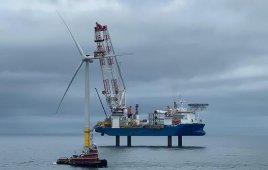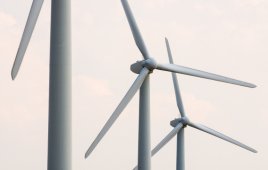
Holly B. McGlinn, CPCU, AU Vice President of Commercial Accounts Alcott Wind Insurance Agency San Diego, CA alcottwindinsurance.com
Looming deadlines of expiring turbine warranties have project owners taking stock of options and planning their next steps. Lender requirements, project lifespan, and maintenance concerns are just a few factors owners must consider. The good news is that there are more options available than ever before. Project owners usually consider a third-party warranty, an OEM’s extended warranty, or a service contract with an O&M. But another option has now emerged: Equipment Maintenance Insurance (EMI).
EMI deviates from the traditional insurance model, and so should not be thought of as such. It is a unique financial tool designed to pinpoint and reduce scheduled and unscheduled maintenance costs for wind turbines in their post-warranty period. Though EMI is new to the wind industry, the medical equipment industry has reaped the benefits for years. Hospitals have saved countless dollars by purchasing EMI policies as their equipment’s OEM warranties expire.
The EMI contract mirrors the OEM warranty on a limited front. Scheduled, routine turbine maintenance is the meat of the policy. This is critical, because insurance typically excludes all routine maintenance. Unscheduled maintenance, both minor and major, can be included when the project owners deem it necessary. Once the covered services are defined, the policy premium and deductible are determined. Together, the premium and deductible represent the maximum out-of-pocket cost (annually) for scheduled maintenance and selected unscheduled maintenance services. Considering the premium and deductible, average cost is at least 15% less than an OEM extended warranty. The project owners can choose a high or low deductible, which will affect the premium accordingly.
For example, assume the annual maintenance contract though the OEM is $1,000,000. An EMI policy can be written as follows: the project owners pay a $250,000 premium and a $600,000 deductible, or choose another option such as a $500,000 premium and $300,000 deductible. If they want “first-dollar” coverage they could even choose an $850,000 premium. In all cases, the max out-of-pocket is $850,000, 15% less than they were paying before.
Once the deductible is met through any combination of scheduled maintenance and covered unscheduled maintenance, or if first-dollar coverage is selected, all invoices for maintenance are submitted to the insurer for payment. In-house repairs accrue toward the deducible as well. It is the project owner’s prerogative to select a maintenance vendor, whether it be an O&M, an OEM service team, or in-house repairs.
In light of today’s challenges in securing project financing, EMI provides a bankable benefit. EMI protects a project from costly maintenance overruns. For the first time, maintenance can be a definitive-line item, instead of a projection, precluding the need for large maintenance reserves.
Financiers can be confident that projects protected by EMI will have the wherewithal to keep their turbines spinning, thus safeguarding the project’s financial health and viability.
EMI is a good choice for project owners who are facing warranty expiration, or already wading through the post-warranty period. Choices bring power and leverage, as different alternatives are weighed. EMI knocks out the variable of maintenance costs, and puts the control back in the hands of the project owner.
WPE
Filed Under: Insurance, Policy





